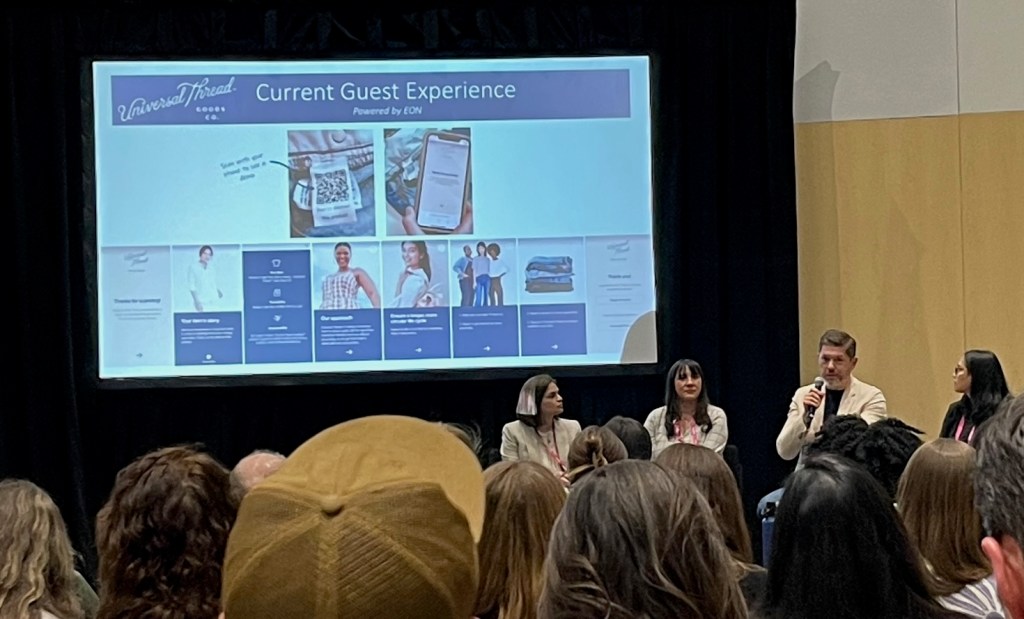By 2040, Target wants to reach net zero climate emissions and design 50 branded product collections “for a circular future.” More immediately, the Minneapolis-based retailer intends to craft its Universal Thread clothing for circularity this year. Target’s move in that direction included embedding digital product passports (DPPs) into millions of units of Universal Thread apparel at the end of 2024.
Target’s DPP approach involves a QR code printed on a tag near the garment’s brand label. Several weeks ago the company launched the option of scanning the code with a smartphone to launch “shop the look” suggestions for related products. It also introduced one-click resale, run by the social re-commerce service Poshmark. Users scan the tag, choose a “sell my item” option, and the product information flows into the listing.
“We’ve got 35 million units now that are in distribution that automatically have integrated resale built into the product,” said Jason Breen, Target’s senior director of owned brand circularity and innovation. He spoke on April 29 at the Trellis Group Circularity 25 event in Denver.
A passport to resale and reuse?
One can think of digital passports as an extension of care tags on clothes. When scanned, DPP-enabled tags surface details about where the product’s materials originated, how it was built and instructions for washing, drying and eventually disposing of it.
The sustainability goals for DPP-enabled tags include helping consumers trace their preferred materials and corporate practices.
The circularity goals include guiding the owner to keep a shirt in wearable shape, and later find responsible resale, repair or recycling options. DPPs are also meant to help logistics companies and recyclers to understand the nature of the product and track it through post-consumer journeys.

“I think of DPPs as the past, present and future of everything we purchase,” said Liz Alessi, founder of Liz Alessi Consulting in New York. “We are just scratching the surface of their potential.”
Target does not have stores in Europe, where companies are racing to adopt DPPs. The European Commission’s Ecodesign for Sustainable Products Regulation require apparel, electronics and other products to include digital passports by 2030.
The Swedish H&M Group’s “sustainable fashion” brand Arket has piloted DPPs. So have Burberry of London and the Dublin-based bra-and-panties brand Bon+Berg. From New York state, Eileen Fisher has experimented with DPPs as well.
Encoding circularity
Target’s circularity requirements include “taking steps to eliminate waste, keep products and materials in use longer, and decrease our dependency on natural resources” for its own branded products.
Several years ago, the company began exploring the potential for DPPs to communicate about circularity, which consumers understand less than recycling, according to Breen. “No one’s asking for a bar code in their jeans,” he said.
Another aim was to assist sorters and recyclers. After taking a risk by front-loading digital tags into one brand, Target is watching consumer engagement before possibly rolling them out to its other brands, Breen noted.
Car seats, denim and the ‘F’ word
The company drew on its earlier large-scale stabs at circularity. Target’s most successful trade-in and recycling program has collected 3 million car seats since 2016. In 2024, it began selling plastic shelving, bins and buckets made from 30 percent plastic downcycled from those car seats, which consumers had exchanged for a coupon. The recycling didn’t perfectly close the loop on waste, according to Breen, but did provide credibility and lessons that can expand beyond car seats.
“What consumers really want is how to manage waste, and how do they get it out of their house,” he said. That became a motivation when Target started prototyping circularity concepts.
That said, the retailer’s attempt at a denim collection program last year was a relative flop, according to Breen. His team was “pumped” during the nine weeks they hustled to assemble a back-to-school program for consumers to bring in old jeans. Working with recycling partner Debrand, they made a plan for an anticipated voluminous amount of fabric but their math was off. The flow of items barely reached projected calculations. Although customers were eager to get rid of car seats, which have few disposal or donation options, the same dynamics don’t apply to clothing.
“Let’s talk about the ‘F’ word: failure,” Breen said. “There are going to be things that you get right and there are going to be things that you are not going to get right.”





